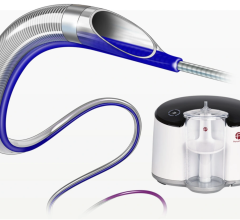Pulmonary embolism (PE) is generally treated with blood thinners, but a more aggressive treatment may be required for massive PE in hemodynamically compromised patients, said Ali Amin, M.D., a vascular surgeon at The Read Hospital and Medical Center in Reading, Pa. In these unstable patients with respiratory distress and near death, he said the AngioJet could be used off-label as an emergency treatment.
“You can use AngioJet in these patients to remove the clot and save their lives,” Amin said. “In these situations, you are not looking to get a perfect picture, you just want to remove enough of the clot to improve the blood pressure and the oxygen saturation.”
Once most of thrombus is removed to improve these factors, he said it is best to stop and continue treating the patient medically. “Your goal is very limited. Once you get oxygen saturation up, your job is done,” he explained.
Peter Soukas, M.D., director of vascular medicine and assistant professor of medicine, Tufts University School of Medicine, St. Elizabeth’s Medical Center, Boston, urges caution with the use of AngioJet in this application. He said people can get very sick if it is used to break up clots in the pulmonary artery, due to the possibility of distal embolization, resulting in acute right ventricular failure. The lysis of red blood cells results in the sudden release of large amounts of adenosine, which may lead to profound bradycardia. For this reason, a temporary pacemaker wire is often used when treating large proximal PE with the AngioJet.
Ekos for Pulmonary Embolism
Ekos plans a randomized clinical trial, ULTIMA (the ULTrasound Accelerated ThrombolysIs of PulMonAry Embolism) to show the clinical benefit of an endovascular device to treat acute submassive pulmonary embolism in comparison to anticoagulation therapy alone. Enrollment is expected to commence in 2010 and be completed by the beginning of 2011.
Pulmonary embolism occurs at a rate of approximately 24 per 100,000 people and accounts for up 150,000 to 500,000 deaths per year in the United States and Europe and affects more than 1.6 million patients annually. Serious pulmonary emboli interfere with the heart’s ability to pump blood into the lungs for oxygenation, causing acute strain of the right side of the heart and potentially causing death.
Current treatments typically involve aggressive anticoagulation or intravenous delivery of clot-dissolving, thrombolytic agents.


 November 07, 2025
November 07, 2025 









